
Who Were
The Cambs
The Cambs
at War
1/1st Btn 1914-1919
1914 - 1/1st Overview
1915 - 1/1st Overview
1915 - St Eloi
1915 - Fosse Wood
1916 - 1/1st Overview
1916 - The Schwaben
1916 - St Pierre Divion
1917 - 1/1st Overview
1917 - St Julien
Insignia, Medals & Books
Remembering The Cambs
Biographies
About Us &
This Site
The Cambs Gunners - A History of the Cambridgeshire Regiment's Machine Gunners
In 1915 alongside the four infantry companies that made up the 1/1st Battalion were a small and very close-knit group of specialist soldiers, hand picked volunteers from across the Regiment. These men made up the 1/1st Battalion’s Machine Gun Section and operated the two Vickers and the two Maxim machine guns. They formed the backbone of the trench defences and were in the thick of the action from St Eloi onwards.
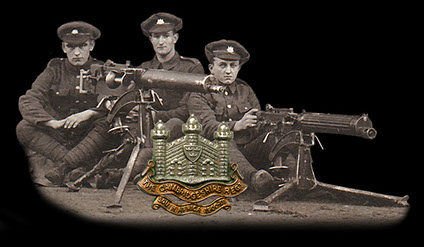
Cambs gunners with their Maxim and Vickers guns in 1915.
Pioneers of the Machine Gun, 1890 - 1908
In 1890 the very pinnacle of military technology was Sir Hiram Maxim’s machine gun. The British Army had adopted it the previous year, but due to the high cost only a handful had actually been delivered. The Volunteer Battalions, who were not centrally funded or equipped, were quick to see this new weapon’s potential and soon some of these units were looking to raise the funds to purchase them. As early as September 1889 the 3rd Cambs VB had announced their intentions to purchase one and numerous events were held around the county to raise the large sum of money needed. After a final successful fund raising concert in Cambridge in early March 1890 the total was reached and the order placed at the cost of around £400 (over £35,000 in today’s money).
The new Maxim gun was delivered to Cambridge in April 1890 and soon a handpicked team began training on its use every week. The gun was a huge coup for the Cambs VB with only around 4 other volunteer units across the country having one and only around 16 having been issued to the Regular Army infantry battalions at this time. Unrestricted by the strict military codes and regulations the volunteer units, such as the Cambs, that adopted the Maxim early on were instrumental in the experimentation and continued development of its use in modern warfare.
The 3rd VB’s gun detachment, all volunteers from the four Cambridge based companies, continued their training on the gun every week and throughout the year they had a minimum of four days at the firing range as well as taking the gun to the annual camp. Membership of this small detachment was a matter of great pride and the standards of turnout and discipline were very high.
The Gun Detachment, 1908 -1914
When the Volunteer Battalions were disbanded in 1908 and the Territorial Force formed in its place, the arming of these new units was centralised. Each of the new Territorial infantry battalions were now to be armed with two Maxim guns, supplied by the War Department. The newly formed Cambridgeshire Battalion took delivery of their second gun in time for the 1908 summer camp. In order to crew them the detachment was expanded and was now made up of: one Lieutenant, one Sergeant, one Corporal, twelve Privates, two Drivers, and the officer’s Batman. In addition to these new recruits other members of the four Cambridge companies could volunteer to undergo a training night on the guns and gain a basic level of understanding in their operation.
The Machine Gun Section, 1914 - 1916
With the outbreak of the War specialist training for the gun detachment was intensified and a reserve pool of trained gunners was built up. Many of these new volunteers came from the four Fenland companies who, up until now, had not been able to join due to the guns being based in Cambridge. Just as the 1/1st Battalion headed for France in February 1915 the number of guns was doubled with the addition of two of the newer Vickers machine guns. These new updated models of the Maxim were lighter and better suited to modern warfare and were to be operated alongside the Cambs two older Maxims.
Now known as the Machine Gun Section, the new volunteers soon fitted in with the pre-war gun detachment and the unit soon built up a strong esprit de corps similar to what had existed in the old VB Gun Detachment. The men referred to themselves with the unofficial title of “Gunner” instead of “Private” and quickly the individual gun teams became very close friends.
The gun teams had the honour of being amongst the first of the Cambridgeshires to enter the front line in March 1915 and they soon began gaining valuable experience. On March 14th several of the gun teams, under the command of Lt “Jack” Ollard, were in the line around St Eloi, spread out amongst some of the other Regular Army battalions that made up their brigade. In the afternoon the Germans launched a surprise attack with waves of infantry rushing the allied positions. In the intense and chaotic fighting that followed the teams went about their work with a merciless and deadly efficiency, one gunner later writing:
Sergt. Bowyer did great execution with the machine gun. He stripped his tunic off, turned up his sleeves, and, cool as the proverbial cucumber, “slipped into it.”
While another summed up the attack:
I must tell you that our gun has slaughtered hundreds of the Germans. It was on the 14th that the Prussian Guards made a charge on our trench… when the big brutes made a dash for our brave lads. They got within ten yards of the trench and it was our Maxim gun that drove them back
For more information on the Cambridgeshires role in the St Eloi defence please click here.
Lt Ollard, suffering from the events at St Eloi, was returned to the UK and was replaced by a recently arrived officer called Francis Allenye Marr. In the months following the attack at St Eloi the gun teams were in the front line every time the infantry companies took their turn. A steady steam of casualties built up, often from sniper fire such as pre-war “Benwick Chicken” John Sutton, but there was never a shortage of men volunteering to join the section. Losses were felt deeply by the Officers and men alike. After “Gunner” Jack Mitchell was killed his friend, “Gunner” Nunn, wrote to his parent to tell them the sad news:
I hardly know how to write and tell you poor Jack was killed in the trenches yesterday, April 26th, about 3 pm, shot through the head while on look out. We thought there was a chance of his recovery, but he died as soon as we got him to the dressing station. He was buried by two of the Gun Section last night in a wood just behind the trenches. We made him a cross and put it on his grave. I have got his watch and ring and various correspondence that he had on him at the time. I will send them on as soon as possible. You do not know with what pain I write this letter. I am sending you the two last letters he wrote… The Gun Section send their deepest sympathy.
Due to the importance and deadly power of machine guns, for both sides, the guns and their crews were a prime target for hostile artillery, rifle grenade, and trench mortar fire. Locations for likely enemy gun positions were well recorded and often subject to sudden random shelling. Great effort was taken to keep the positions concealed and strict fire discipline was kept so as to not reveal the guns unnecessarily. At night duels between opposing machine gun positions were commonplace, especially during raids and other offensive operations.
Many of the men of the section were well known due to their keenness and abilities as good soldiers. On numerous occasions the gunners volunteered or were selected for dangerous operations, one such example of this is the small intelligence gathering operation carried out by 2nd Lts Hopkinson and Gill at Armentieres. The two men who accompanied them on this risky nighttime mission to the German front line were both from the gun section. For his repeated gallant attempts under heavy fire to rescue the wounded 2nd Lt Hopkinson that night L/Cpl Jimmy Day was awarded the DCM.
The section also suffered losses from the random nature of enemy artillery bombardments. In late June, while in the line near Armentieres, a German shell fell short of its target behind the front line and by chance landed directly on a dugout being used by the section. The shell killed L/Cpl Marking and wounded two other gunners, it also mortally wounded Capt R Sindall who was walking past at the time.
In November the battalion left the 27th Division and was posted to the 3rd Army School at Flixecourt, the Machine Gun Section were fully involved with life at the School. Training and various drills were carried out daily along with lessons and demonstrations of new techniques in both attack and defence. While the training and display schedule was intense during the day most evenings the gun teams were free to enjoy the relaxed nightlife at the numerous cafes around the town. More information on the time at Flixecourt can be found by clicking here.
In February 1916 the Cambs left the comfort and security of Flixecourt and were posted to the 118th Brigade, 39th Division. Just as they were adjusting to this new posting orders came through that were to mean dramatic changes for the Machine Gun Section. After the British Army’s experiences on the Western Front in 1915 it had been decided to form a dedicated Regular Army corps for all machine gunners – The Machine Gun Corps. This new unit was to absorb the gun sections from all infantry battalions and form them into dedicated machine gun companies, one for each brigade. For the Cambs gunners this meant leaving their regiment and the Territorial Force and reenlisting in the Regular Army as part of the MGC.
The good news for the gunners was that although they would no longer be part of the Cambridgeshires they were to form the 118th Company along with the gun sections from the other three battalions (4th/5th Black Watch, 1/1st Herts, and 1/6th Cheshires) that made up their brigade. The role of this new machine gun company was to provide guns and crews for the brigade, so while no longer under the Cambridgeshire cap badge the gunners would continue to fight alongside their old comrades.
The 118th Company, Machine Gun Corps, 1916 - 1918
On March 21st, 1916 40 men of the Cambs Machine Gun Section were rebadged and renumbered as part of the Machine Gun Corps. Both Lt Assherton and 2nd Lt Gore, the 1/1st Bn’s Machine Gun Officers, were also attached to the MGC. Additional Cambs men joined the 118th Coy over the coming months. The men also said their farewells to their two old trusty Maxims which were both now replaced with the newer Vickers models. Less that two week later the gun teams from the newly formed company began taking their turns in the front line around the Moated Grange sector. The crews wasted no time in getting into action and during their first night each gun fired around 500 rounds and one enemy MG was silenced.
Over the next six month the 118th Coy continued to support their old infantry battalions in the front line. The heavy fire power that the guns provided coming into full effect during hostile raids and also giving vital supporting fire for any friendly offensive operations. As well as direct fire on enemy positions the machine guns were also used for indirect fire, where the guns would be angled up, firing over long distances, so as the bullets would arc down on a target area.
By October 1916 the 118th Coy had spent around six weeks on the Somme and had been involved in numerous supporting fire operations. In late September, in support of a massive II Corps attack, the 16 machine guns of the Company fired over 320, 000 rounds in four days alone. On October 6th the 118th moved back from the front line and started making preparations for their role in the planned attack on the Schwaben Redoubt. The Company was to provide supporting fire from the front line and 5 guns and their crews, along with additional men to carry extra ammunition, were also detailed to go over with the attacking infantry and take up positions in the captured redoubt. On hearing that the main assault was to be spearheaded by the 1/1st Cambs their old comrades in the 118th Coy were keen to fight beside them and many of the gun teams tasked with going over were the ex Cambs gunners.
The attack, launched on the afternoon of October 14th, was a huge success. The attacking gun crews were soon in the thick of the action, one team engaging a stubborn German machine gun at near point blank range from a shell hole, they then continued to support the attack until their gun was destroyed and all the men wounded. Several of the other attacking guns were also quickly put of action and many of their crews wounded. Replacement guns and crews were brought up from the reserve and these, along with the two original guns that made it to the trenches of the Schwaben, went on to provide crucial heavy fire that helped secure the captured shattered earthworks.
The gun crews remained at their posts in the captured redoubt and improved the positions as best they could. The following day the battered infantry were relieved by fresh troops but the 118th Coy crews remained. By October 16th 12 of their guns were still in action, 2 listed as having been destroyed and 2 out of action due to broken check lever plates. Later in the day the gun crews still holding the redoubt played an important part in halting a German attack on the North Eastern corner of the captured position. Several hours later the exhausted crews and their guns began to be relieved and were pulled back for a long overdue rest away from the front line.
For their part in the heroic capture and defence of the Schwaben numerous 118th Coy men were recognised for their bravery including ex Cambs gunner Sgt Percy Walker who was awarded the Military Medal. Percy went on to be awarded a bar to his MM for his bravery the following year at Tower Hamlets, where, once again, he took his guns up in close support of his old Cambs Regt comrades as they attacked.
After recovering and taking on fresh reinforcements the gunners were soon back in the line and took part in the successful attack at St Pierre Divion in November. By the end of the year they found themselves back in the Ypres Salient and throughout the long winter and spring of 1917 the gun crews continued to support their infantry comrades holding the front line. In late March the venerable CSM George Bowyer left the 118th Coy, returning to the UK. George had been with the gun detachment from the early Volunteer days and his bravery and skill during the fighting at St Eloi 1915 had been recognized with the award of a retrospective Military Medal. He returned to the Western Front later in the war, this time as part of the newly formed Tank Corps.
As summer arrived and with it the long awaited British offensive around Ypres, the 118th Coy was again involved in very heavy fighting. During the British attack near the Menin Road on September 26th the ex Cambs gunners were once again on the offensive alongside their old comrades, with several guns and their crews being detailed to push up amongst the attacking Cambridgeshires.
As autumn moved into winter activity calmed a little in the Salient, although casualties were still taken in the attritional nature of daily trench warfare. Numerous German trench raids were beaten back by the guns, some engagements taking place at a matter of a few yards. A tragic heavy blow for the company was struck on November 14-15th when Sgt Harold Webb was killed. One of the original 40, Sgt Webb had been awarded the Military Medal several months earlier for his gallantry during the Passchendaele fighting and he had been a pre-war member of the Cambridgeshires, originally enlisting in 1913.
In early 1918 a total restructuring of the MGC took place and the individual machine gun companies in each division were merged together to form larger machine gun battalions. On March 1st the 118th Coy became C Company of the 39th Battalion, MGC.
39th Battalion, Machine Gun Corps, 1918 - 1919
Three weeks after its formation the 39th Bn was caught up in the middle of the German Spring Offensive, C Coy was initially attached to support the 118th Brigade. After over a week of bitter fighting and desperate rear guard actions the gun teams often found themselves fighting with composite units sometimes as riflemen. However despite the distance covered in the retreat and the ferocity of the fighting the Battalion was still able to proved operational guns and crews at all times.
After some time recovering C Coy were temporarily attached to the 153 Infantry Brigade and took part in very heavy fighting during the Battle of the Lys. During this time, due to the heavy losses sustained by the 39th Division it was decided to reduce it to cadre strength and move the various units to other divisions. The 1/1st Cambridgeshires left the 39th Division and, after over three years on the Western Front, were separated from the few remaining original Cambs gunners. The 39th Bn also left the 39th Division and were made the First Army’s Army Machine Gun Battalion.
For the remainder of the War the 39th Bn was attached to a variety of units and took part in many of the ferocious battles that made up the Hundred Days Offensive. Amazingly by September 1918 there were still a few of the original 40 Cambs gunners serving in the Battalion. The last of these to be killed while still serving with the unit was L/Cpl Charles Asplen from Cambridge. He was killed by shrapnel from an enemy shell while bringing up rations to his comrades on September 3rd, 1918, he is buried at Monchy Cemetery, east of Arras. Charles had originally joined the Cambridgeshires in January 1914 and had served overseas for over 40 months without a scratch.
After the Armistice the Battalion was slowly reduced to cadre strength and finally returned to the UK in March 1919 where it was disbanded. Of the initial draft of 40 Cambs gunners 10 had been killed in the fighting on the Western Front and many of the others were wounded, often multiple times. The individual acts of gallantry during the war by the draft were rewarded with the award of one DCM, one MM and Bar, and three MMs.
Legacy
In the years following the Great War the Cambridgeshire Regiment was reborn as part of the new Territorial Army. Once again the Vickers machine gun became an integral component of the battalion’s order of battle. As the call went out for men to once again return to the Colours some of the old gunners answered, including a handful of the pre-war gun detachment. These battle-hardened masters of the machine gun soon set about training the new young volunteers and once again the hand picked gun section, with its four Vickers, began to develop the esprit de corps of its forebears.
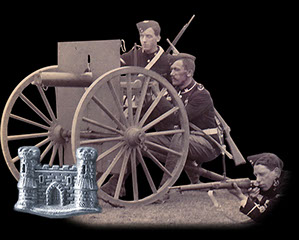
Volunteers & their Maxim at camp.
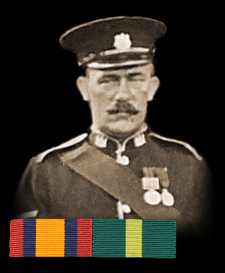
George Bowyer in 1914.
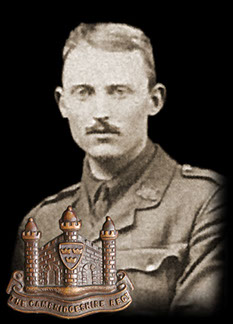
Lt "Jack" Ollard before going to France.
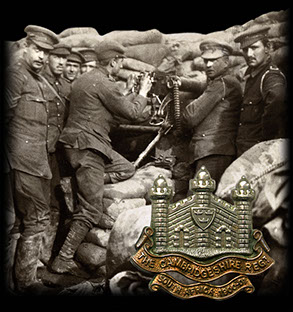
Maxim gun and crew in the trenches.
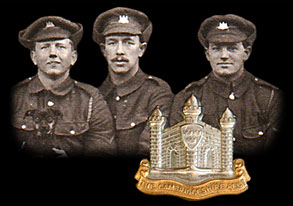
Gun Section members: L/Cpl Brand (holding the section mascot), L/Cpl "Jimmy" Day DCM, & L/Cpl "Porkie" Stearn in late 1915
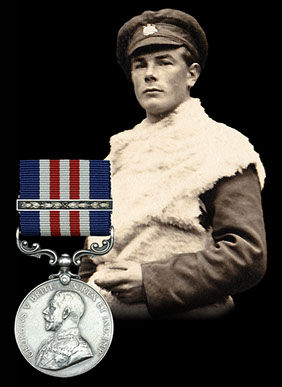
Percy Walker MM & Bar in early 1916.
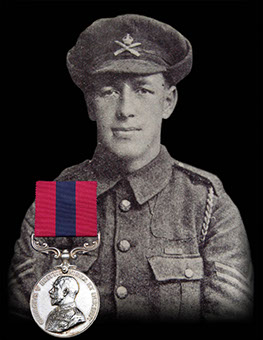
Cpl Day DCM while serving with the 118th.
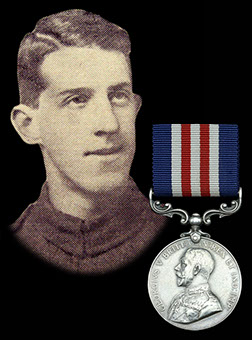
Harold Webb MM, killed in November 1917.
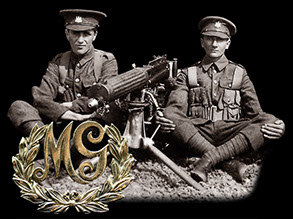
Territorial Army Cambridgeshires in 1923.

This site went live on the 14th February 2015 to mark 100 years since the 1/1st Cambs went off to war.
WE WILL REMEMBER THEM
Email us: cambsregt@gmail.com
Copyright 2015, 2016, 2017, 2018, 2019 by Felix Jackson. The information and images on this site should not be reproduced without prior permission.